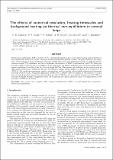Files in this item
The effects of numerical resolution, heating timescales and background heating on thermal non-equilibrium in coronal loops
Item metadata
| dc.contributor.author | Johnston, C. D. | |
| dc.contributor.author | Cargill, P. J. | |
| dc.contributor.author | Antolin, P. | |
| dc.contributor.author | Hood, A. W. | |
| dc.contributor.author | De Moortel | |
| dc.contributor.author | Bradshaw, S. J. | |
| dc.date.accessioned | 2019-04-29T10:30:01Z | |
| dc.date.available | 2019-04-29T10:30:01Z | |
| dc.date.issued | 2019-05 | |
| dc.identifier | 258601314 | |
| dc.identifier | c74272d7-12df-44ad-a536-356874f94d03 | |
| dc.identifier | 000469357400004 | |
| dc.identifier | 000469357400004 | |
| dc.identifier | 85073695102 | |
| dc.identifier.citation | Johnston , C D , Cargill , P J , Antolin , P , Hood , A W , De Moortel & Bradshaw , S J 2019 , ' The effects of numerical resolution, heating timescales and background heating on thermal non-equilibrium in coronal loops ' , Astronomy & Astrophysics , vol. 625 , A149 . https://doi.org/10.1051/0004-6361/201834742 | en |
| dc.identifier.issn | 0004-6361 | |
| dc.identifier.other | ORCID: /0000-0003-2620-2068/work/58755450 | |
| dc.identifier.other | ORCID: /0000-0003-4023-9887/work/58755530 | |
| dc.identifier.other | ORCID: /0000-0002-1452-9330/work/58984281 | |
| dc.identifier.uri | https://hdl.handle.net/10023/17602 | |
| dc.description | Funding: European Research Council (ERC) under the European Union’s Horizon 2020 research and innovation programme (grant agreement No 647214) and the UK Science and Technology Facilities Council through the consolidated grant ST/N000609/1. P.A. has received funding from his STFC Ernest Rutherford Fellowship (grant agreement No. ST/R004285/1). | en |
| dc.description.abstract | Thermal non-equilibrium (TNE) is believed to be a potentially important process in understanding some properties of the magnetically closed solar corona. Through one-dimensional hydrodynamic models, this paper addresses the importance of the numerical spatial resolution, footpoint heating timescales and background heating on TNE. Inadequate transition region (TR) resolution can lead to significant discrepancies in TNE cycle behaviour, with TNE being suppressed in under-resolved loops. A convergence on the periodicity and plasma properties associated with TNE required spatial resolutions of less than 2 km for a loop of length 180 Mm. These numerical problems can be resolved using an approximate method that models the TR as a discontinuity using a jump condition, as proposed by Johnston et al. (2017a, A&A, 597, A81; 2017b, A&A, 605, A8). The resolution requirements (and so computational cost) are greatly reduced while retaining good agreement with fully resolved results. Using this approximate method we (i) identify different regimes for the response of coronal loops to time-dependent footpoint heating including one where TNE does not arise and (ii) demonstrate that TNE in a loop with footpoint heating is suppressed unless the background heating is sufficiently small. The implications for the generality of TNE are discussed. | |
| dc.format.extent | 14 | |
| dc.format.extent | 26330145 | |
| dc.language.iso | eng | |
| dc.relation.ispartof | Astronomy & Astrophysics | en |
| dc.subject | Sun: corona | en |
| dc.subject | Sun: magnetic fields | en |
| dc.subject | Magnetohydrodynamics (MHD) | en |
| dc.subject | Hydrodyanmics | en |
| dc.subject | Sun: transition region | en |
| dc.subject | Sun: oscillations | en |
| dc.subject | QB Astronomy | en |
| dc.subject | QC Physics | en |
| dc.subject | NDAS | en |
| dc.subject | BDC | en |
| dc.subject.lcc | QB | en |
| dc.subject.lcc | QC | en |
| dc.title | The effects of numerical resolution, heating timescales and background heating on thermal non-equilibrium in coronal loops | en |
| dc.type | Journal article | en |
| dc.contributor.sponsor | European Research Council | en |
| dc.contributor.sponsor | Science & Technology Facilities Council | en |
| dc.contributor.sponsor | Science & Technology Facilities Council | en |
| dc.contributor.institution | University of St Andrews. Applied Mathematics | en |
| dc.contributor.institution | University of St Andrews. School of Mathematics and Statistics | en |
| dc.identifier.doi | 10.1051/0004-6361/201834742 | |
| dc.description.status | Peer reviewed | en |
| dc.identifier.grantnumber | 647214 | en |
| dc.identifier.grantnumber | ST/N000609/1 | en |
| dc.identifier.grantnumber | ST/R004285/1 | en |
This item appears in the following Collection(s)
Items in the St Andrews Research Repository are protected by copyright, with all rights reserved, unless otherwise indicated.

